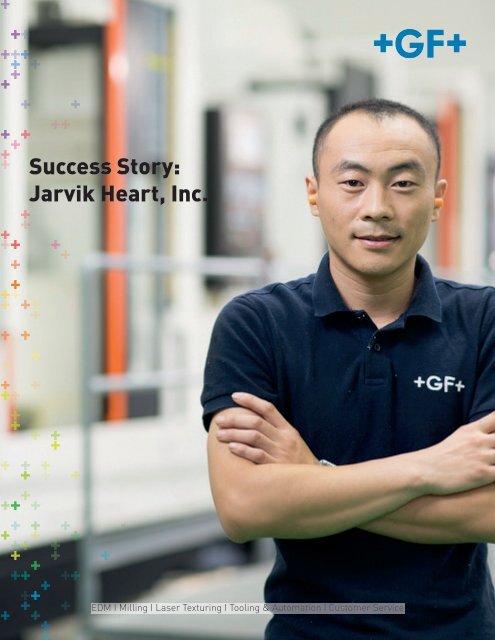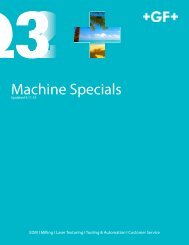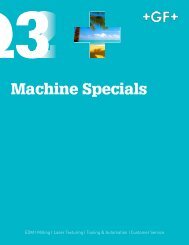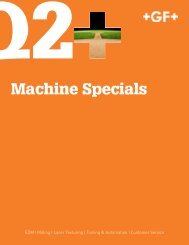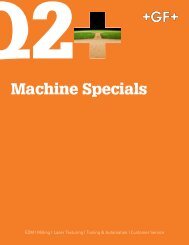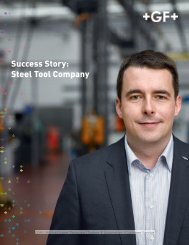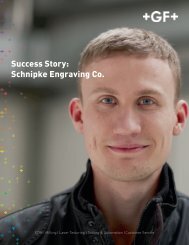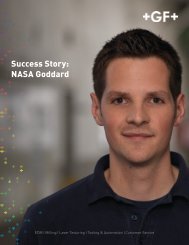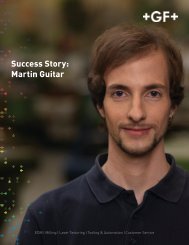Jarvik Heart, Inc.
You also want an ePaper? Increase the reach of your titles
YUMPU automatically turns print PDFs into web optimized ePapers that Google loves.
Success Story:<br />
<strong>Jarvik</strong> <strong>Heart</strong>, <strong>Inc</strong>.<br />
EDM I Milling I Laser Texturing I Tooling & Automation I Customer Service
The Best Way Usually Isn’t the Easiest<br />
For some manufacturing sectors, pursuing the easiest means<br />
of production is an acceptable goal. For manufacturers of<br />
sensitive medical devices, such an approach is rarely possible,<br />
let alone preferable. <strong>Jarvik</strong> <strong>Heart</strong>, <strong>Inc</strong>. of New York defines its<br />
goal as pursuing the best solution and then working to make<br />
it possible. A recent installation of a GF AgieCharmilles wire<br />
EDM machine demonstrates the company’s constant commitment<br />
to excellence, even when it is far from easy to accomplish.<br />
Dr. Robert <strong>Jarvik</strong> possesses over thirty years of experience<br />
in the field of medical device design and production. Working<br />
with a team of researchers at the University of Utah in the<br />
1970’s, he developed the <strong>Jarvik</strong>-7, the world’s first total artificial<br />
heart designed to provide lifelong support. Since 1987,<br />
he has continued his efforts to develop devices for people<br />
with severe heart failure at a facility occupying four floors of<br />
a building in Manhattan. Recently, this unique location presented<br />
a significant hurdle in implementing the best available<br />
production solution.<br />
In April 2004, <strong>Jarvik</strong> <strong>Heart</strong> was awarded a $5 million contract<br />
from the National Institutes of Health (NIH). The goal was to<br />
develop a miniaturized version of the highly successful <strong>Jarvik</strong><br />
2000 VAD (Ventricular Assist Device) for use in children and<br />
infants with congenital heart defects. At present, children with<br />
such conditions face extremely dire odds.<br />
There is a cumulative 50% mortality rate for the multiple<br />
operations necessary in the first two years of life for children<br />
with some of the more serious heart defects. After that, only<br />
one in ten children receive a donor heart. Additionally, those<br />
lucky few may spend years waiting, with a reduced quality of<br />
life due to liver damage, fluid build-up in the abdomen and<br />
other associated complications. The development of a permanent<br />
VAD will have tremendously positive effects on these<br />
children born with the cards stacked against them.<br />
For nearly four years, Dr. <strong>Jarvik</strong> and his team worked tirelessly<br />
to reduce the size of the <strong>Jarvik</strong> 2000 to the point where<br />
it would be suitable for pediatric use. Unfortunately, smaller<br />
designs created a host of problems.<br />
“We found that we could not just shrink the existing design,”<br />
says Dr. <strong>Jarvik</strong>. “With a smaller pump, we continually had<br />
problems with thrombus formation within the device. This was<br />
a severe problem, as it would eventually lead to premature<br />
pump failure. A small thrombus would form around the bearings<br />
and cause enough friction to stop the rotor from spinning.<br />
The tiny motors don’t have enough torque to overcome this<br />
binding force.”<br />
Late in 2007, Dr. <strong>Jarvik</strong> made a breakthrough in the concept of<br />
a pediatric VAD. While the exact details are confidential, it can<br />
be said that the turning point involved a redesign of the bearings<br />
used in the pump. Extensive calculations and initial prototype<br />
testing suggested that the solution had been found and<br />
the question became how best to machine the component.<br />
It would require several sharp angles and levels of accuracy<br />
and surface finish exceeding the capabilities of <strong>Jarvik</strong> <strong>Heart</strong>’s<br />
existing equipment, so the team began examining its options.<br />
“We found ourselves in a very tight spot,” says Dr. <strong>Jarvik</strong>. “Our<br />
annual review with NIH was just over two months away and we<br />
felt it was imperative that we be able to prove the benefits of<br />
the new design in that time. Because of its size and requirements,<br />
we knew the part would need to be machined on a wire<br />
EDM. It was a matter of finding the right machine and proceeding<br />
with its installation as quickly as possible.”<br />
After some initial investigation into the capabilities of various<br />
makes and models of machines, <strong>Jarvik</strong> <strong>Heart</strong> requested test<br />
cuts from several EDM manufacturers. Based on the results,<br />
the company chose the AC Classic V2 from GF AgieCharmilles.
The machine features the IPG-V generator that increases<br />
pulses’ shape factor while shortening the pulse duration,<br />
allowing it to obtain high accuracy and surface finish. These<br />
areas are also bolstered by the machine’s unique toroids that<br />
activate during taper cutting, which increases the wire tensile<br />
force. The machine provided exactly the results <strong>Jarvik</strong> <strong>Heart</strong><br />
needed and the next challenge was obtaining the machine in<br />
time to produce tangible results prior to the NIH review.<br />
Once the order had been placed, GF AgieCharmilles began<br />
preparations for an expedited delivery. This process uncovered<br />
a significant problem. The opening to the freight elevator in<br />
<strong>Jarvik</strong> <strong>Heart</strong>’s building was approximately 4” narrower than<br />
the width of the AC Classic V2. Given the sensitivity of the<br />
project, GF AgieCharmilles immediately formed a team to address<br />
the challenge. Employees from the GF AgieCharmilles<br />
Refurbishment, Advanced Technical Support and Northeast<br />
Regional Service departments came together to devise a solution.<br />
It quickly became clear that the only option was to disassemble<br />
a machine for delivery and then reassemble it on-site.<br />
An AC Classic V2 was delivered to GF AgieCharmilles’ Lincolnshire<br />
facility, where it was immediately stripped of sheet metal<br />
and peripherals. A team of technicians then disassembled the<br />
machine, carefully identifying and marking every component,<br />
connection and fitting. The machine made the journey to New<br />
York in six crates.<br />
In January 2008, four engineers from GF AgieCharmilles traveled<br />
to <strong>Jarvik</strong> <strong>Heart</strong> to reassemble the machine. A special<br />
hoist was created to aid in the unconventional installation.<br />
After several days, <strong>Jarvik</strong> <strong>Heart</strong> had its new wire EDM, its<br />
condition indistinguishable from a machine fresh off of the<br />
production line.<br />
<strong>Jarvik</strong> <strong>Heart</strong>’s 2008 NIH review went extremely well, with all<br />
parties impressed by the breakthroughs the team had made.<br />
While developed for infants, the new design has potential ramifications<br />
for all those who suffer from life threatening heart<br />
disease. To be effective, the pediatric VAD needed to be able<br />
to increase its output to match the growing body of its host. In<br />
an infant, it would require operation at 20,000 rpm to achieve<br />
the necessary blood flow. As that child grows, the pump’s rpm<br />
increases to drive a greater amount of blood. Initial evaluation<br />
of the new design indicates that the pump is capable of<br />
maintaining 70,000 rpm, pumping enough blood for an adult.<br />
Due to its much smaller size, the new pump could considerably<br />
reduce the risks and complexity of the surgery necessary<br />
to implant a VAD.<br />
“The new model holds tremendous promise,” says Dr. <strong>Jarvik</strong>.<br />
“The fit of the bearings is so perfect that the amplitude of<br />
radial vibrations possible is on the order of 10 to 20 millionths<br />
of an inch. When the pump is running at 70,000 rpm underwater,<br />
it is nearly silent and you can hold it and feel practically no<br />
vibration.”<br />
The pediatric VAD will soon be used in its first animal implants.<br />
If that produces the expected results, a long period of<br />
clinical trials will be necessary. As with all medical devices,<br />
full acceptance and integration of the product will be a lengthy<br />
process due to regulatory hurdles.<br />
“Each improvement to the design of a VAD becomes somewhat<br />
more difficult,” explains Dr. <strong>Jarvik</strong>. “Once we had a<br />
device that proved effective for two years, people then wanted<br />
one that would last for five. Once we cleared that hurdle,<br />
people wanted one that would last for ten. And once one<br />
model receives those results, the regulatory bodies want<br />
every model to achieve those results. In effect, each success<br />
we achieve lengthens the time it will take to develop our next<br />
improvement.”<br />
That challenge does not faze the team of forty employees<br />
working with Dr. <strong>Jarvik</strong>. They recognize that the road to improving<br />
people’s lives will always have significant hurdles to<br />
overcome. For <strong>Jarvik</strong> <strong>Heart</strong>, the reward is worth making the<br />
effort to always strive for the best possible results.<br />
To further aid in meeting the deadline imposed by <strong>Jarvik</strong><br />
<strong>Heart</strong>, applications specialists from GF AgieCharmilles assisted<br />
in development of the complex programming needed to<br />
complete the prototype Dr. <strong>Jarvik</strong> had envisioned. In the end,<br />
the part was completed to the exact specifications required.<br />
“The AC Classic V2 delivered the precision and surface finish<br />
demanded by the part,” says Dr. <strong>Jarvik</strong>. “We have to hold steep<br />
angles within a 0.016º tolerance, while having the machine<br />
provide surface finish of around 0.15 µm. It’s a demanding application<br />
and we couldn’t do it without the innovations found in<br />
GF AgieCharmilles’ wire EDM.”
GF Machining Solutions<br />
GF Machining Solutions<br />
560 Bond Street<br />
Lincolnshire, IL, 60069<br />
USA<br />
Website: www.gfms.com/us<br />
Email: info.gfms.us@georgfischer.com<br />
Phone: 847-913-5300<br />
© Machining Solutions, 2015<br />
The technical data and illustrations are not binding.<br />
They are not warranted characteristics and are<br />
subject to change.<br />
Facebook: facebook.com/gfmachiningsolutions<br />
Twitter: twitter.com/gfms_us<br />
YouTube: youtube.com/agiecharmilles<br />
Version 1.1


